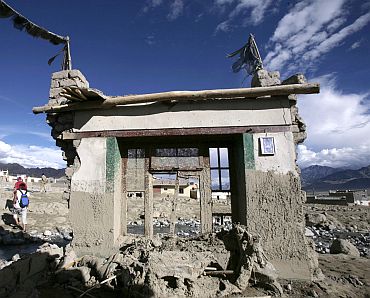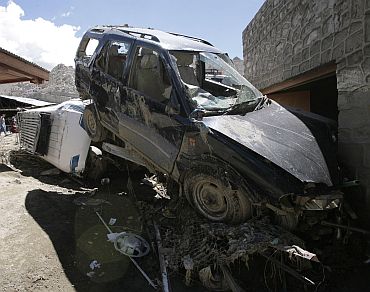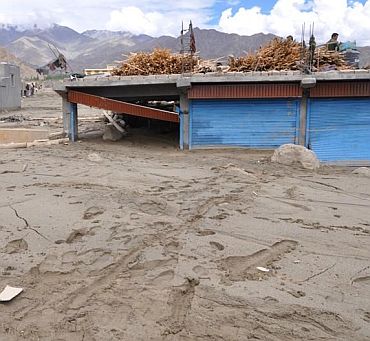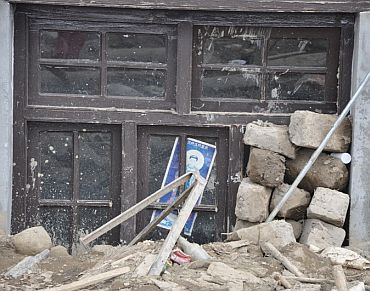Photographs: Mukesh Gupta/Reuters
Based on detailed analysis of weather data of last five years in Leh, Ladakh, scientists have attributed the recent cloudburst in the region to prolonged winters, which may be due to climate change.
"After going through the sequence of events of the weather that led to the cloudburst on August 6, it has been reinforced that the catastrophe was due to prolonged winters being witnessed in the region," sources in Leh-based Defence Institute For High Altitude Research (DIHAR) said.
...
Also Read:
Ladakh: Paradise shattered
When Mother Nature turns on humans
The reason behind Leh's devastation
Image: A monk performs religious rites for flash floods victims on the outskirts of LehPhotographs: Mukesh Gupta/Reuters
On condition of anonymity, he said at a recent meeting on "Evaluation of climate change in Ladakh sector and causes of Cloud Burst in Leh," the scientists led by DIHAR director Sashi Bala had analysed the weather data of the last five years in terms of monthly temperature, rainfall, humidity and snowfall.
The reason behind Leh's devastation
Image: Flash flood victims walk near the wreckage of damaged cars after flash floods in LehPhotographs: Mukesh Gupta/Reuters
The study indicated that increased temperature and hot summers in the plains lead to increased evaporation and subsequent cloud formation in the hills.
"This in turn, led to increased duration of snowfall in Ladakh when compared to previous years.
"The winters in Ladakh were found to be prolonged," the experts concluded though they felt the phenomenon could not be directly associated with climate change given the short range of data.
The reason behind Leh's devastation
Image: Shopping establishments under the rubble in LehPhotographs: Tarun Vijay
The region was witnessing unusual phenomenon of bright sunshine in the June and July months causing melting of snow and high relative humidity (72%) as compared to previous years (50%), the scientist said.
Tracing the change in weather on the basis of the data available, he pointed out that "since snow absorbed the latent heat also, the monthly maximum and minimum temperature remained low and did not shoot up as compared to previous years (2006).
"The low temperature and high relative humidity lead to formation of dense low clouds in the valley.
Since the vapour content in the clouds were high and on trying to cross the glaciers, the vapours further condensed.
The reason behind Leh's devastation
Image: Lord Buddha on the window of a house in ruinsPhotographs: Tarun Vijay
"The clouds could not retain the water droplets that lead to the cloudburst. Since the rainfall was absent on 3rd, 4th and 5th August and was negligible on 7th, 8th and 9th August the theory of occurrence of a cloudburst in Leh due to prolonged winters may be reinforced," the meeting said on the sequence of event.
The cloudburst, which led to flash floods and mudslides, claimed about 180 lives and injured about 400 people, besides causing widespread damage to public and private property.
The Defence establishment has also initiated research towards preventing soil erosion in case of heavy rains in the area in future in view of climate change.
The reason behind Leh's devastation
Image: Relief camps located on higher ground in LehPhotographs: Tarun Vijay
Meanwhile, Russia will help in building high altitude 'green houses' in cities like Leh in Ladakh for providing fresh vegetables for the jawans and civilians in remote mountain areas.
A Memorandum of Understanding to this effect was signed on Moscow by the visiting director of Defence Research & Development Organisation (DRDO) Pramod Shukla and Alexander Demidov of the Russian Science Academy's Main Botanical Garden named after N V Tsitin.
"Under this MOU, high altitude Green Houses will be set up using Russian expertise in Indian cities like Leh in Ladakh, as well as the two organisations will in the field of bio-diversity, bio-engineering and bio-technology," Shukla said.
The reason behind Leh's devastation
Photographs: Tarun Vijay
Initially three Green Houses would be built with the support of Russia's M/s Stroi Project. The environmentally controlled Green House will also help to develop variety of cold-tolerant, vegetables.
"These Green Houses will have large collections of rare plants, flora & fauna, which could be used in medical, health promotion and other useful technologies. These joint research projects would not only benefit our soldiers working at high attitude but also the civilian population," he underscored.
DRDO has also signed another MoU with Moscow State University for joint research activities in the sustainable eco-friendly agro technologies suitable for Himalayan region.








article